-
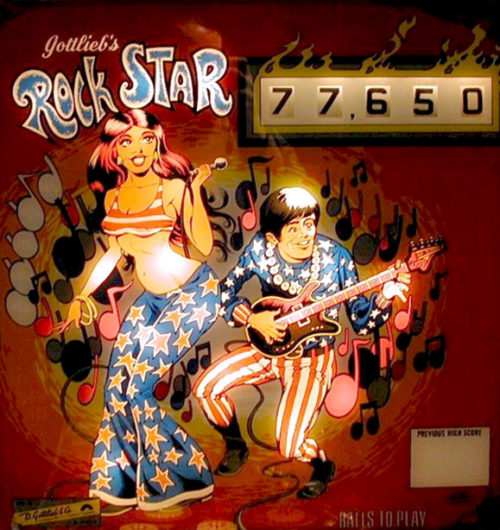 The game before you is extremely rare with only 278 screwed together at the Chicago Gottlieb factory. This one-player electromechanical add-a-ball game was designed by John Osbourne with art by Gordon Morison. A replay version was also designed by the name of Blue Note. The object of this machine is to complete all the notes down the left side of the playfield. Doing so activates the classic “wow” feature which, when hit, awards one free ball. A reset is in your future once your current ball drains. Score is another way to achieve longer play by winning extra balls. The spinner in the middle of the playfield awards big points when 1,000 points is lit; each spin of the target awards 1,000 points plus number of revolutions spun. A nice retro art package completes this rare machine.
The game before you is extremely rare with only 278 screwed together at the Chicago Gottlieb factory. This one-player electromechanical add-a-ball game was designed by John Osbourne with art by Gordon Morison. A replay version was also designed by the name of Blue Note. The object of this machine is to complete all the notes down the left side of the playfield. Doing so activates the classic “wow” feature which, when hit, awards one free ball. A reset is in your future once your current ball drains. Score is another way to achieve longer play by winning extra balls. The spinner in the middle of the playfield awards big points when 1,000 points is lit; each spin of the target awards 1,000 points plus number of revolutions spun. A nice retro art package completes this rare machine. -
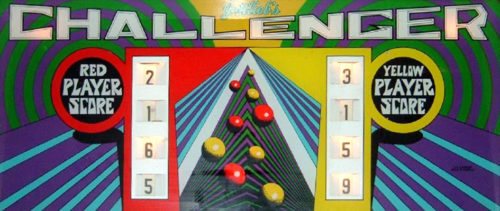 Here is one you do not see every day. This is a Gottlieb Challenger from 1971. Only 110 of these were produced back in the day. How many are still around now … head-to-head pinball game with two players at opposite ends of the playfield, simultaneous soccer like play, can not be played with one player. Each player has flipper buttons which control only those flippers facing the opponent. Ball enters play from between the flippers. Game has 8 flippers and vertically mounted score reels. The playfield actually tilts towards and away from the players, depending on which end served the ball.
Here is one you do not see every day. This is a Gottlieb Challenger from 1971. Only 110 of these were produced back in the day. How many are still around now … head-to-head pinball game with two players at opposite ends of the playfield, simultaneous soccer like play, can not be played with one player. Each player has flipper buttons which control only those flippers facing the opponent. Ball enters play from between the flippers. Game has 8 flippers and vertically mounted score reels. The playfield actually tilts towards and away from the players, depending on which end served the ball. -
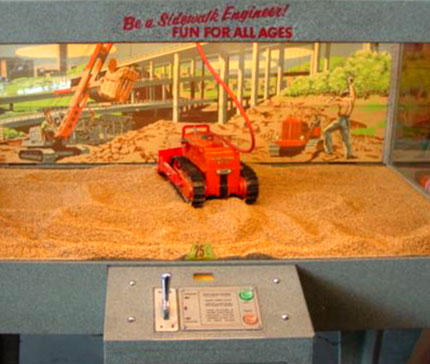 This Williams machine fabricated in 1955 is a strange game that really is more of a toy. A player gets to operate a remote-controlled bulldozer around a big sandbox for 120 seconds using two remote controllers in synthetic gravel. It appears the idea for this machine was to cater to the under-12 market as no rewards, extra time, or extra plays were programmed into the electromechanical boards within the machine. No scoring and no prizes! This machine was often confused with Williams’ Crane (1956) because it has a sign on top of the game that says, “Be a sidewalk engineer.” Ten cents allowed adults a two-minute break to get a quick snack while a child was entertained. I don’t think this would be the case in today’s thinking…
This Williams machine fabricated in 1955 is a strange game that really is more of a toy. A player gets to operate a remote-controlled bulldozer around a big sandbox for 120 seconds using two remote controllers in synthetic gravel. It appears the idea for this machine was to cater to the under-12 market as no rewards, extra time, or extra plays were programmed into the electromechanical boards within the machine. No scoring and no prizes! This machine was often confused with Williams’ Crane (1956) because it has a sign on top of the game that says, “Be a sidewalk engineer.” Ten cents allowed adults a two-minute break to get a quick snack while a child was entertained. I don’t think this would be the case in today’s thinking… -
 This game is the pinball rendition of the HBO TV show, The Sopranos, complete with voices of most of the actors in the series. It was designed by George Gomez with the art package created by Kevin O’Conner. The main object of the machine is to advance through the ranks of the mob by advancing your status through playfield rollovers and cracking the safe. Doing so is difficult to achieve to top capo. A multiball feature is also incorporated into the game behind a solo drop target. Video modes must be achieved to complete the placard of events culminating in the completion of your missions. So many pop bumper hits light up the party at the bing in the upper right, which scores a bunch of points. Mastering this machine is tough, but that’s what brings you back to try again.
This game is the pinball rendition of the HBO TV show, The Sopranos, complete with voices of most of the actors in the series. It was designed by George Gomez with the art package created by Kevin O’Conner. The main object of the machine is to advance through the ranks of the mob by advancing your status through playfield rollovers and cracking the safe. Doing so is difficult to achieve to top capo. A multiball feature is also incorporated into the game behind a solo drop target. Video modes must be achieved to complete the placard of events culminating in the completion of your missions. So many pop bumper hits light up the party at the bing in the upper right, which scores a bunch of points. Mastering this machine is tough, but that’s what brings you back to try again. -
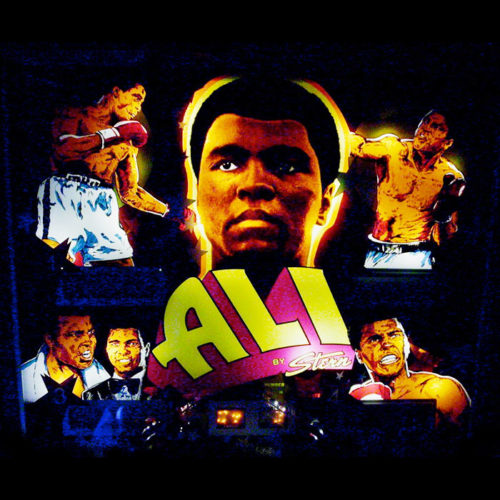
-
Gottlieb released the game “Sinbad” in both solid-state and electromechanical formats in June of the year. Designed by Ed Krynski with art by Gordon Morison, there were 12,000 S.S. games and 950 E.M. games made. This machine is the rare two-player version of the game, of which 730 were made. Drop targets are the main theme of this game. Knocking down the single white drop target awards a 2x bonus and lights the white rollover. The three yellow drops were next. If hit, 3x bonus is awarded when the ball drains and the 5,000 rollover lights at the top of the playfield. The four purple drops were next. Making these would award 4x bonus and light the extra ball rollover. Finally, the five red drops; when hit would award 5x bonus (the maximum bonus that could register is 15,000 points times the bonus) as well as light the special rollover. Four flippers allowed for interesting play, also.
-
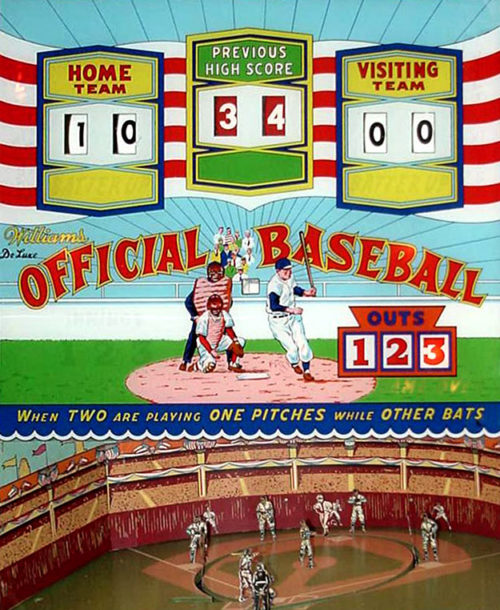 Official Baseball, Williams #232, 2/60, two players, woodrail with players on the playfield and animated umpire and pitcher, plus a running man unit. Uses 3/4″ balls. Very often the playfield men get broken from the ball play (or the catcher is just plain missing!) A very cool woodrail (maple side rail) baseball arcade game with hole style scoring (opposed to the 1963 and later target scoring scheme), and a very good looking game. Two player game, so competitive play is encouraged. High score is kept, with a default of 15 runs as the minimum high score to beat. Game can be set for one to three innings per game. Game uses a buzzer which sounds between innings and players. Most of the players have lights under their fielding hole. If the light is on, the runner advances if the ball goes in this hole. If the light is out, the field hole is an out. Whether the light is on or off is determined by how many players are currently on base (via the running man unit in the backbox). So hitting to the first basemen’s field hole could get the player an out or a single. Official baseball is easily the best looking of all post-WW2 pitch and bat baseballs. With the metal playfield men and classic design, it’s a handsome game. It is not though the best playing of the Williams pitch and bats. Since it does not have a home-run deck (like most of the other Williams p&b games), it’s not riveting from a game play perspective. But the pitching unit (the umpire hands the ball to the pitcher, and then the pitcher moves forward to pitch the ball).
Official Baseball, Williams #232, 2/60, two players, woodrail with players on the playfield and animated umpire and pitcher, plus a running man unit. Uses 3/4″ balls. Very often the playfield men get broken from the ball play (or the catcher is just plain missing!) A very cool woodrail (maple side rail) baseball arcade game with hole style scoring (opposed to the 1963 and later target scoring scheme), and a very good looking game. Two player game, so competitive play is encouraged. High score is kept, with a default of 15 runs as the minimum high score to beat. Game can be set for one to three innings per game. Game uses a buzzer which sounds between innings and players. Most of the players have lights under their fielding hole. If the light is on, the runner advances if the ball goes in this hole. If the light is out, the field hole is an out. Whether the light is on or off is determined by how many players are currently on base (via the running man unit in the backbox). So hitting to the first basemen’s field hole could get the player an out or a single. Official baseball is easily the best looking of all post-WW2 pitch and bat baseballs. With the metal playfield men and classic design, it’s a handsome game. It is not though the best playing of the Williams pitch and bats. Since it does not have a home-run deck (like most of the other Williams p&b games), it’s not riveting from a game play perspective. But the pitching unit (the umpire hands the ball to the pitcher, and then the pitcher moves forward to pitch the ball). -
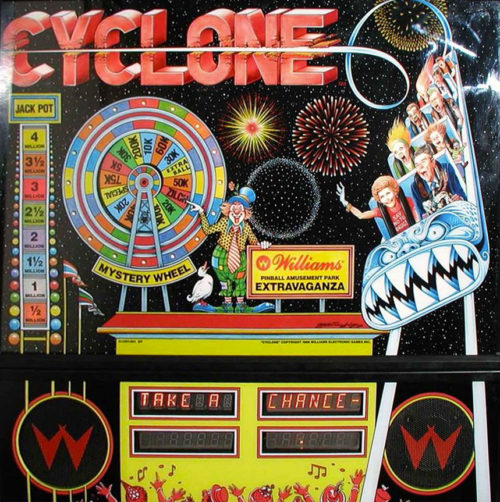 This machine is one in a trilogy that Williams produced with an amusement park theme. 9,400 were made with design accolades going to Barry Oursler and art by Python Anghelo. Ronald and Nancy Reagan appear on the backglass. The Comet and Cyclone are two roller coasters from the Coney Island era. If you ride the Comet ramp six times, a million-point shot is possible. The Cyclone ramp in the upper right awards the accumulated jackpot on the backglass if hit three times. Hitting the spook house drop target exposes a gobble hole which spins the backglass wheel for a point award or extra ball. A ferris wheel bonus a shooting gallery bonus and a bonus multiplier shot in the lower left complete this impressive package. “You pay your money, you take your chances” in this classic machine.
This machine is one in a trilogy that Williams produced with an amusement park theme. 9,400 were made with design accolades going to Barry Oursler and art by Python Anghelo. Ronald and Nancy Reagan appear on the backglass. The Comet and Cyclone are two roller coasters from the Coney Island era. If you ride the Comet ramp six times, a million-point shot is possible. The Cyclone ramp in the upper right awards the accumulated jackpot on the backglass if hit three times. Hitting the spook house drop target exposes a gobble hole which spins the backglass wheel for a point award or extra ball. A ferris wheel bonus a shooting gallery bonus and a bonus multiplier shot in the lower left complete this impressive package. “You pay your money, you take your chances” in this classic machine. -

-
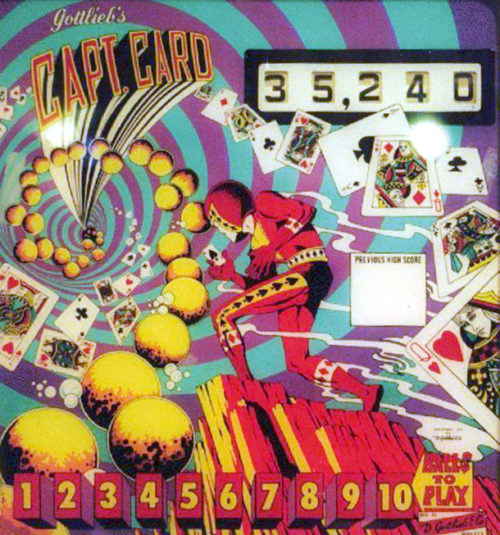 May was the release month for this game. Designer Ed Krynski and artist Gordon Morison put together the package. Production run was low, at 675 units. This is an add-a-ball game variant, the replay version was called High Hand. The challenging part of this playfield design is trying to lock a ball in the eject hole for extra balls. Four batteries of drop targets in four colors are along the sides of the playfield. Making a completion of a color of drop targets increases the value of the eject and side drains. If all the drop targets are completed, the extra ball features light up. Score is another way to win balls set by the operator. No match units were incorporated into these games as, again, that was considered a form of gambling, i.e. winning a free game.
May was the release month for this game. Designer Ed Krynski and artist Gordon Morison put together the package. Production run was low, at 675 units. This is an add-a-ball game variant, the replay version was called High Hand. The challenging part of this playfield design is trying to lock a ball in the eject hole for extra balls. Four batteries of drop targets in four colors are along the sides of the playfield. Making a completion of a color of drop targets increases the value of the eject and side drains. If all the drop targets are completed, the extra ball features light up. Score is another way to win balls set by the operator. No match units were incorporated into these games as, again, that was considered a form of gambling, i.e. winning a free game. -
 This game was developed with the Beatles craze of the day in mind, as you can see the caricatures of the Fab Four incorporated into the art of the machine. The production run of this two-player game was 2,802 units. Designed by the legendary Steve Kordek with art by Jerry Kelley, the object of the game is to complete all four quadrants of the clock image by hitting the 3,6,9 and 12 quadrants. Doing so advances the bonus system of scoring, lights extra ball features and one special feature. An interesting part of the game design was the stepped target in the middle of the play field. Hitting this target would score the target value currently displayed and the target advances 90 degrees to the next target. Each new ball resets the clock to zero completed parts. The operator had the ability to adjust the points needed for free games, the number of score levels, if a special awarded a free game or an extra ball, and the option of three- or five-ball play.
This game was developed with the Beatles craze of the day in mind, as you can see the caricatures of the Fab Four incorporated into the art of the machine. The production run of this two-player game was 2,802 units. Designed by the legendary Steve Kordek with art by Jerry Kelley, the object of the game is to complete all four quadrants of the clock image by hitting the 3,6,9 and 12 quadrants. Doing so advances the bonus system of scoring, lights extra ball features and one special feature. An interesting part of the game design was the stepped target in the middle of the play field. Hitting this target would score the target value currently displayed and the target advances 90 degrees to the next target. Each new ball resets the clock to zero completed parts. The operator had the ability to adjust the points needed for free games, the number of score levels, if a special awarded a free game or an extra ball, and the option of three- or five-ball play. -
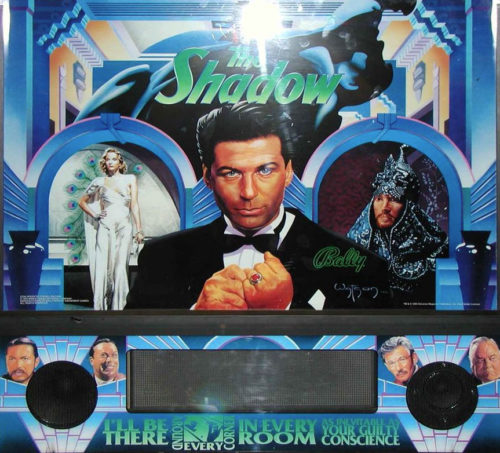 This machine is based on the ’30s radio series then turned into a movie. Design accolades go to Brian Eddy with art scripted by Doug Watson. 4,247 of these machines were made. The interesting feature in this machine is the elevated upper-left playfield. This playfield is gained access to once the drop target is hit. Once this challenge is complete, another shot to this ramp shoots the ball upstairs to this feature. Pressing the flipper buttons moves the paddle left or right. The kicker is activated by an optic sensor automatically to hit all the targets if your aim is sure. This game also has a thrust magnet which grabs the ball in action and shoots it up the playfield into the next feature. No pop bumpers are on the playfield, which is a rare event. Another first incorporated into this playfield are two ramp diverters which are player adjustable. Completing the six scenes of the story award you with the final battle sequence of good against evil.
This machine is based on the ’30s radio series then turned into a movie. Design accolades go to Brian Eddy with art scripted by Doug Watson. 4,247 of these machines were made. The interesting feature in this machine is the elevated upper-left playfield. This playfield is gained access to once the drop target is hit. Once this challenge is complete, another shot to this ramp shoots the ball upstairs to this feature. Pressing the flipper buttons moves the paddle left or right. The kicker is activated by an optic sensor automatically to hit all the targets if your aim is sure. This game also has a thrust magnet which grabs the ball in action and shoots it up the playfield into the next feature. No pop bumpers are on the playfield, which is a rare event. Another first incorporated into this playfield are two ramp diverters which are player adjustable. Completing the six scenes of the story award you with the final battle sequence of good against evil.